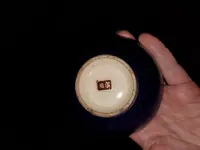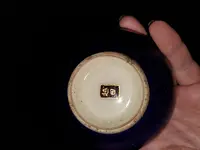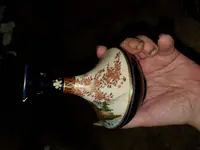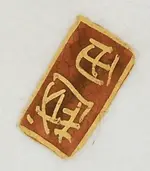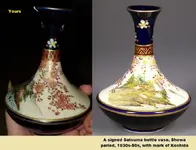You are using an out of date browser. It may not display this or other websites correctly.
You should upgrade or use an alternative browser.
You should upgrade or use an alternative browser.
Not found detecting but....
- Thread starter boojababy
- Start date
- Joined
- Apr 24, 2010
- Messages
- 12,923
- Reaction score
- 27,656
- Golden Thread
- 1
- Location
- Upper Canada 🇨🇦
- 🥇 Banner finds
- 1
- 🏆 Honorable Mentions:
- 3
- Detector(s) used
- XP Deus, Lesche Piranha 35 Shovel & 'Garrett Carrot'
- Primary Interest:
- Relic Hunting
Looking at the mark, it looks like you have a piece of Satsuma Ware Pottery. 
"Satsuma ware is a type of Japanese pottery originally from Satsuma Province, southern Kyūshū. Today, it can be divided into two distinct categories: the original plain dark clay early Satsuma made in Satsuma from around 1600, and the elaborately decorated export Satsuma ivory-bodied pieces which began to be produced in the nineteenth century in various Japanese cities. By adapting their gilded poly-chromatic enamel over-glaze designs to appeal to the tastes of western consumers, manufacturers of the latter made Satsuma ware one of the most recognized and profitable export products of the Meiji period.
The incredible popularity of Satsuma ware and the eagerness of collectors to find pre-Meiji pieces led some manufacturers and dealers to deliberately misrepresent item's age and origins. Some sold other types of ceramics such as Awata or Seto ware as Satsuma. Some falsely used the names of famous artists or studios to mark pieces. Early Japanese ceramics rarely had stamps or signatures, which can make dating some Satsuma ware difficult. One characteristic of earlier pieces, however, is a high-quality glaze and finish, as later mass production led to dramatically inferior works. Another telling feature of genuine pieces is that their bodies do not ring when tapped."
Dave

"Satsuma ware is a type of Japanese pottery originally from Satsuma Province, southern Kyūshū. Today, it can be divided into two distinct categories: the original plain dark clay early Satsuma made in Satsuma from around 1600, and the elaborately decorated export Satsuma ivory-bodied pieces which began to be produced in the nineteenth century in various Japanese cities. By adapting their gilded poly-chromatic enamel over-glaze designs to appeal to the tastes of western consumers, manufacturers of the latter made Satsuma ware one of the most recognized and profitable export products of the Meiji period.
The incredible popularity of Satsuma ware and the eagerness of collectors to find pre-Meiji pieces led some manufacturers and dealers to deliberately misrepresent item's age and origins. Some sold other types of ceramics such as Awata or Seto ware as Satsuma. Some falsely used the names of famous artists or studios to mark pieces. Early Japanese ceramics rarely had stamps or signatures, which can make dating some Satsuma ware difficult. One characteristic of earlier pieces, however, is a high-quality glaze and finish, as later mass production led to dramatically inferior works. Another telling feature of genuine pieces is that their bodies do not ring when tapped."
Dave
Attachments
Upvote
0
Plug N Play
Bronze Member
- Joined
- Aug 23, 2014
- Messages
- 1,315
- Reaction score
- 3,573
- Golden Thread
- 0
- Location
- California
- Detector(s) used
- De Havilland Canada DHC-7-102 Dash 7 - Fugro
- Primary Interest:
- All Treasure Hunting
Upvote
0
Similar threads
- Replies
- 0
- Views
- 165
- Replies
- 1
- Views
- 246
Users who are viewing this thread
Total: 1 (members: 0, guests: 1)

